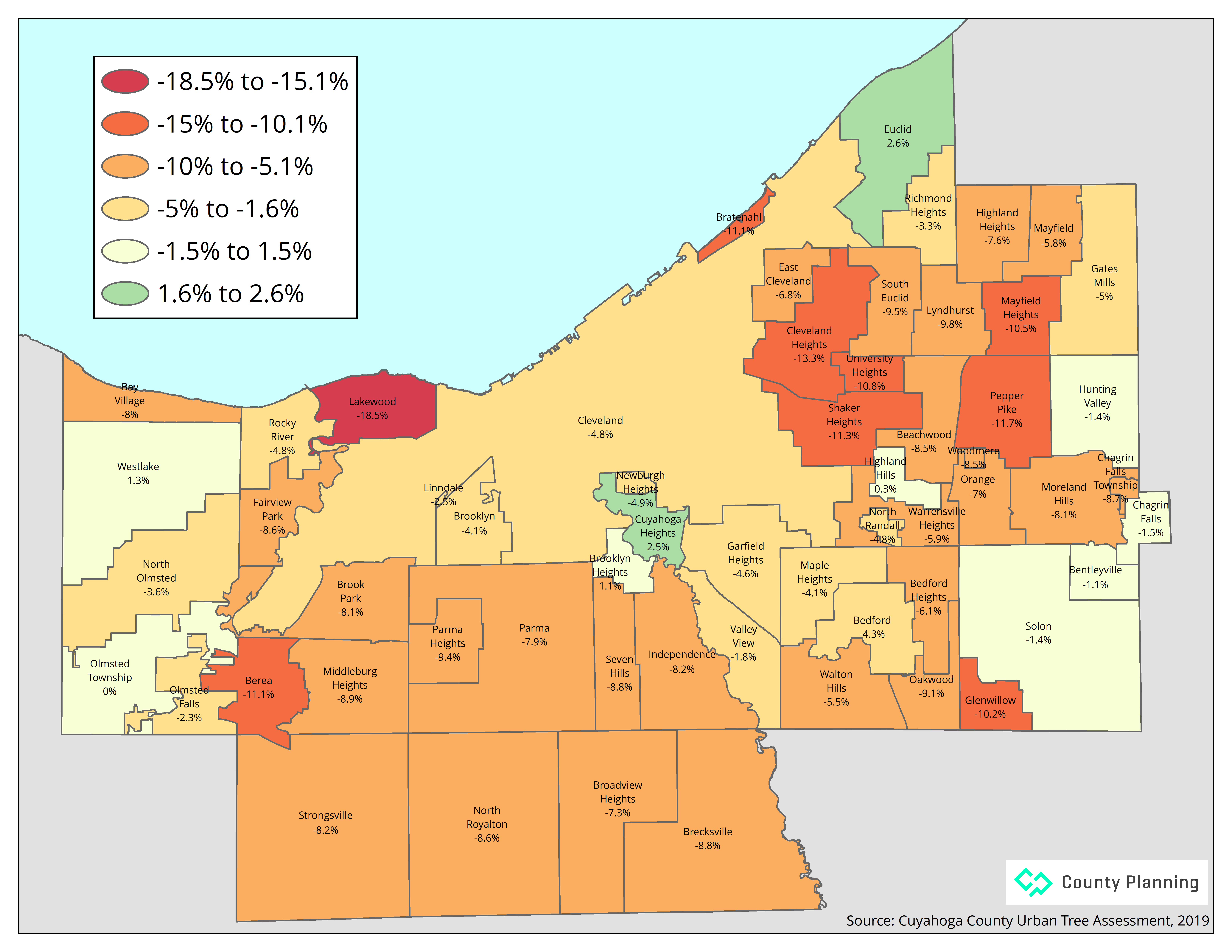
Newly-Released Urban Tree Canopy Assessment Finds Loss in Tree Canopy Since 2011
Report shows 6,600-acre loss in tree canopy but over 370,000 acres available to plant in County
The Cuyahoga County Planning Commission released today the findings of the 2019 Urban Tree Canopy Assessment. The last assessment was released in 2013, and most recent data is available from 2017 based on LIDAR data collection from the Northeast Ohio Regional Sewer District and Cleveland Metroparks.
Tree canopy is the layer of leaves, branches, and stems of trees that cover the ground when viewed from above. Tree canopy provides many benefits to society, including moderating climate, reducing building energy use and atmospheric carbon dioxide, improving air and water quality, mitigating rainfall runoff and flooding, enhancing human health and social well-being and lowering noise impacts.
The 2019 update shows that just over 100,000 acres of the county were covered by tree canopy in 2017, representing 34.7 percent of all land in the county. This is compared to a coverage of 37 percent in 2011. Losses in tree canopy are often due to development, natural loss from invasive pests, and other causes such as wind damage and neglect.
“Cuyahoga County is the most densely populated county in the State of Ohio,” said County Executive Armond Budish. “While protecting our existing tree cover is a challenge, our Climate Change Action Plan and its tree canopy initiative will make a real difference in the health of the canopy.”
The findings of the assessment also showed over 370,000 acres of the county available for possible tree canopy. In September, the County invested $950,000 into funding for 26 community tree projects. This funding spurred the creation of 18 tree plans, nine tree maintenance plans and 14 tree inventories for area municipalities, neighborhoods and nonprofits.
“This assessment has showed us that our efforts to sustain and grow the existing tree canopy will be impactful in the coming years and have a positive impact on water quality and summer temperatures,” said Director of Sustainability, Mike Foley. “The grants we awarded this year and our commitment to contribute $1 million dollars for each of the next five years to revitalize the tree canopy are steps in the right direction.”
Data for each of the 59 municipalities in Cuyahoga County is also referenced in the assessment. Community-level metrics for tree canopy can serve as a realistic basis for a community to develop goals, policies and possibly legislation for the management of trees.
“Although we made gains in some areas, the continued loss of the overall tree canopy in Cuyahoga County highlights the need to continue our efforts both at the county and local levels,” said County Planning Commission Executive Director, Shawn Leininger. “These efforts need to be comprehensive in educating our residents and businesses about the importance of trees and their maintenance, as well as to work with our partners throughout the region to protect the existing tree canopy, replace tree canopy that is lost, and plant new trees to increase the canopy where opportunities allow.”
Assessment partners include Cleveland Neighborhood Progress, the City of Cleveland Office of Sustainability, Holden Forests & Gardens, Western Reserve Land Conservancy, the Northeast Ohio Regional Sewer District and Cleveland Metroparks. Land cover analysis was conducted by the Spatial Analysis Laboratory (SAL) at the University of Vermont’s Rubenstein School of the Environment and Natural Resources.
“We thank the Cuyahoga County Planning Commission for this important update on the state of our urban forest,” said Director of Community Partnerships at Holden Forests & Gardens and Co-Chair of the Cleveland Tree Coalition, Sandra Albro. “Because of the many benefits that trees provide, we know that a healthy urban forest is essential to the wellbeing of urban communities. These findings will help us prioritize investment in trees in places where they can contribute to equity and resilience.”

